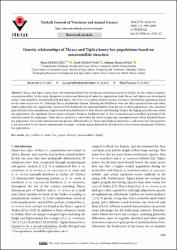| dc.contributor.author | Kekeçoğlu, Meral | |
| dc.contributor.author | Ünal, Emel Özkan | |
| dc.contributor.author | Soysal, Mehmet İhsan | |
| dc.date.accessioned | 2022-05-11T14:46:43Z | |
| dc.date.available | 2022-05-11T14:46:43Z | |
| dc.date.issued | 2021 | |
| dc.identifier.issn | 1300-0128 | |
| dc.identifier.uri | https://doi.org/10.3906/vet-2103-12 | |
| dc.identifier.uri | https://hdl.handle.net/20.500.11776/10354 | |
| dc.description.abstract | Thrace and Yigilca honey bees, two important honey bee ecotypes in apicultural activity of Turkey, are the subject of genetic conservation effort. In this study, the genetic structure and diversity of honey bee populations from Thrace and Yigilca were investigated using 27 microsatellites. Except Kirklareli and Yigilca (Fst: 0.14), it was observed lower genetic divergence between the populations based on the value of pairwise Fst. Although Thrace populations (Edirne, Tekirdag and Kirklareli) were not fully separated from each other, Yigilca population was significantly separated from Kirklareli and separated slightly from the rest of other populations. The calculated gene diversity of the populations ranged from 0.44 in Kirklareli to 0.56 in Edirne and Tekirdag. Despite the high genetic diversity within the populations, the significant heterozygous deficiency found in Kirklareli may be due to repeated and controlled swarming of the selected colonies by beekeepers. These factors could have contributed the observed genotypic homogenization within Kirklareli honey bee population. Our results demonstrate that genetic differantiation of Thrace and Yigilca populations is still conserved, but gene flow is not prevented by the current management strategies, creating urgent demand for an improved conservation management of honey bee populations. | en_US |
| dc.description.sponsorship | Duzce UniversityDuzce University [20100501038] | en_US |
| dc.description.sponsorship | The research was supported by Duzce University Scientific Research fund through A research project (DUBAP Project no:20100501038). We thank beekeepers for providing the honey bee samples and their cooperation. We also thank Davud Gur for his support during the collection of some of the samples for this study. | en_US |
| dc.language.iso | eng | en_US |
| dc.publisher | Scientific Technical Research Council Turkey-Tubitak | en_US |
| dc.identifier.doi | 10.3906/vet-2103-12 | |
| dc.rights | info:eu-repo/semantics/openAccess | en_US |
| dc.subject | Apis mellifera L | en_US |
| dc.subject | honey bee | en_US |
| dc.subject | genetic diversity | en_US |
| dc.subject | microsatellites | en_US |
| dc.subject | Turkey | en_US |
| dc.subject | Apis-Mellifera L. | en_US |
| dc.subject | Turkish Honeybees | en_US |
| dc.subject | Turkey | en_US |
| dc.subject | Diversity | en_US |
| dc.subject | Software | en_US |
| dc.subject | Hymenoptera | en_US |
| dc.subject | Anatoliaca | en_US |
| dc.subject | Caucasica | en_US |
| dc.subject | Ecotypes | en_US |
| dc.subject | Regions | en_US |
| dc.title | Genetic relationships of Thrace and Yigilca honey bee populations based on microsatellite structure | en_US |
| dc.type | article | en_US |
| dc.relation.ispartof | Turkish Journal of Veterinary & Animal Sciences | en_US |
| dc.department | Fakülteler, Ziraat Fakültesi, Zootekni Bölümü | en_US |
| dc.authorid | 0000-0001-7460-4040 | |
| dc.identifier.volume | 45 | en_US |
| dc.identifier.issue | 6 | en_US |
| dc.identifier.startpage | 999 | en_US |
| dc.identifier.endpage | 1009 | en_US |
| dc.institutionauthor | Ünal, Emel Özkan | |
| dc.institutionauthor | Soysal, Mehmet İhsan | |
| dc.relation.publicationcategory | Makale - Uluslararası Hakemli Dergi - Kurum Öğretim Elemanı | en_US |
| dc.authorscopusid | 36150926700 | |
| dc.authorscopusid | 8431541400 | |
| dc.authorscopusid | 6701528877 | |
| dc.identifier.wos | WOS:000731915100004 | en_US |
| dc.identifier.scopus | 2-s2.0-85122622910 | en_US |
| dc.identifier.trdizinid | 519165 | en_US |



















